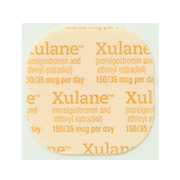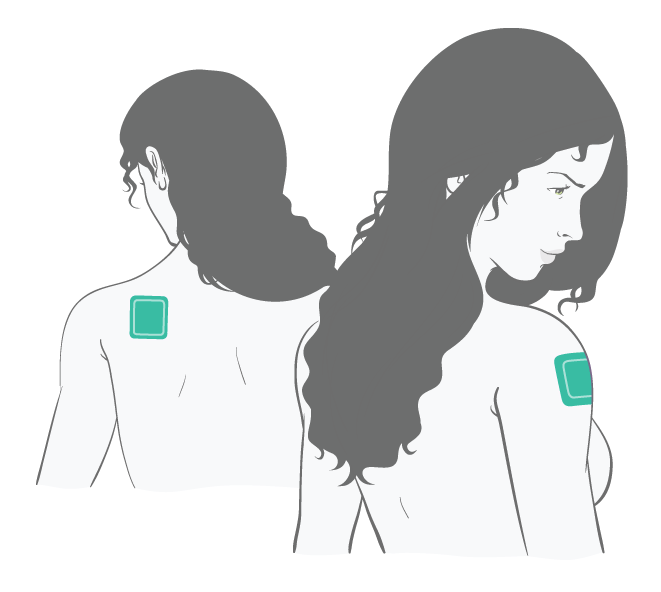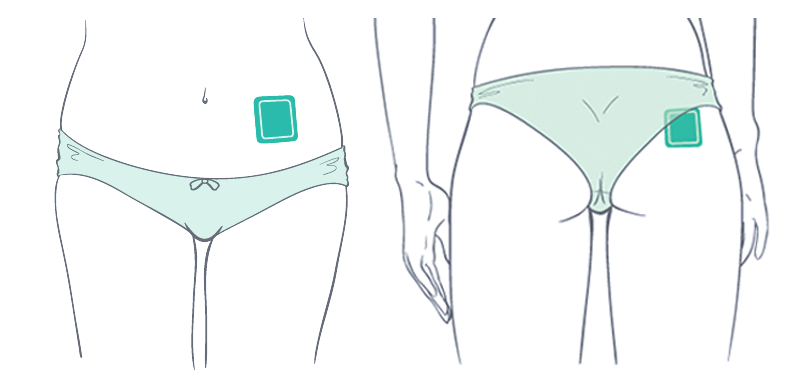- Birth control
- Birth control patch
Birth control patch

What is the birth control patch?
The patch is a birth control method that sticks to your skin like a small Band-Aid or a patch you would use to help you stop smoking. It contains two different kinds of hormones, estrogen and progestin, that work together to prevent pregnancy. These hormones are absorbed through your skin. The main way they prevent pregnancy is by stopping ovulation from happening, which means that your ovaries don’t release an egg.
All of the patch options are a little less than two inches across. Two are square and one is round, and all of them are only one color—beige. There are three names the patch is sold under: Xulane, Zafemy, and Twirla. Twirla has a lower dose of hormones than Zafemy and Xulane, but it’s still really effective at preventing pregnancy.
Quick Facts
-
Effectiveness
The patch is very effective the way most people use it.
Perfect use: Over 99% effective
Typical use: 93% effective
What are perfect use and typical use?
-
Hormones
The patch contains two kinds of hormones, estrogen and progestin.
-
Side effects
Nausea, irregular bleeding, headaches, and sore breasts are the most common side effects, but they’re usually temporary. Some people also have skin irritation when using the patch.
-
Cost
Could be as low as $0 a month (with insurance) or as high as $44 a month.
-
STI protection
The patch doesn’t protect against STIs.
-
Ongoing effort
You have to change your patch once a week.
The birth control patch may be right for you if…
Effectiveness at preventing pregnancy is a top priority for you.
Xulane and Zafemy are 99% effective at preventing pregnancy when used perfectly, meaning that, on average, less than one out of every 100 people using Xulane or Zafemy perfectly for a year will get pregnant. Because Twirla has a lower dose of hormones than Xulane and Zafemy, it is a little bit less effective. Twirla is 95% effective at preventing pregnancy when used perfectly (exactly as directed). That means that, on average, about five out of every 100 people using Twirla perfectly for a year will get pregnant.
However, the effectiveness of the patch with perfect use is based on the experiences of people involved in clinical trials who are using the patch perfectly for an entire year. The effectiveness of the patch with typical use, which means how effective it is when real people use it in real life, where people sometimes make mistakes, is going to be more relevant for most people. In the case of the birth control patch, when it’s used as people typically use it, it is 93% effective at preventing pregnancy. That means that, on average, seven out of every 100 people using the patch for a year as most people use it will get pregnant.
The effectiveness of the patch is partly dependent on body weight. Xulane and Zafemy may not be as effective if you weigh more than 198 pounds, and Twirla may not be as effective if you have a BMI of 25 or more.
You want to put in relatively little effort for your birth control to work.
If remembering to take a pill every day is not for you, the patch might be a good option. You only have to remember to take action once a week: put a new patch on (and take the old one off) for the first three weeks of the month, and then have one patch-free week.
You want to know when you’ll get your period.
If you feel comforted by getting your period every month—and not having random spotting or bleeding in between periods—the birth control patch could be a good choice for you.
Keep in mind that when you’re on the birth control patch, the bleeding that can happen during your patch-free week is not actually a period, it’s called withdrawal bleeding. The amount of bleeding and when it comes depends on how long you’ve been on the patch and your body’s hormones. It’s common for people who have been using the patch for a while to have very light bleeding or no bleeding at all. There’s no need for concern if you stop having bleeding all of a sudden.
You want the option to skip periods.
If you want to skip a period, instead of having a patch-free week after three weeks with a patch on, you can just put a new patch on for the fourth week like you would the other three weeks of each month. You can skip a single period this way or multiple periods throughout the year. You can even skip all of your periods for a year by using a patch continuously (with no patch-free weeks). Keep in mind that you cannot just leave the third patch of the month on for an extra week—the amount of hormones in each patch is only enough to cover one week. Also, if you use the patch continuously, you will use extra patches over the course of a year, and your insurance may not pay for the extra patches.
You aren’t looking for STI protection, or you’re okay with combining the patch with another method.
The birth control patch doesn’t offer any STI protection. So if that’s something you’re looking for, you can use condoms or internal condoms along with the patch. Dental dams and/or gloves can also offer STI protection, depending on what kind of sex you’re having. You may also want to consider PrEP (pre-exposure prophylaxis), which is a daily pill or an injection you can get every two months to decrease your risk of getting HIV.
You want a method that won’t affect your future fertility.
The only birth control method that permanently affects your fertility is sterilization. You may be able to get pregnant again as quickly as a few days after stopping the patch. That could be a good thing if pregnancy is in the near future for you. But if you don’t want to get pregnant right away, you’ll need to use an alternate method as soon as you stop using the patch.
You want a method that you can stop without help from a provider.
You can stop using the patch anytime without having to see a health care provider. Just remember that once you stop, you will quickly return to whatever level of fertility was normal for you before being on the patch.
You don’t need to hide your method.
The patch is not one of the methods that is easy to completely hide, and it is especially hard to hide from a partner. You may be able to hide it from people who are not seeing your body without clothes, but it will depend on where on your body you put the patch. One thing to keep in mind is that both Xulane and Zafemy have their brand names printed on the patch itself, so if someone can see your patch, they can see the name of the medication you’re getting.
It’s proven to be effective in people at your weight.
We don’t know for sure, but the Xulane and Zafemy patches may be less effective if you weigh more than 198 pounds. If your BMI is 25 or greater, Twirla may be less effective at preventing pregnancy.
You don’t have any of these risk factors.
For most people, the risk of blood clots while using the patch is very low. However, there are some things that greatly increase your risk, like:
- Previously having had a blood clot or having certain inherited conditions that increase your risk for a blood clot.
- Smoking cigarettes if you’re 35 years old or older.
- Having uncontrolled high blood pressure.
- Having heart disease or having had a heart attack or a stroke.
- Having recently had major surgery if you won’t be able to get out of bed for a while.
- Having migraine with aura.
- Having had a baby less than three weeks (21 days) ago.
- Having tested positive for antiphospholipid antibodies.
It’s also not recommended that you use the patch if you have or have had:
- Breast cancer.
- Serious liver disease.
- Complications of diabetes.
- An organ transplant.
If you have any of these risk factors, it’s not recommended that you use either type of ring, the patch, or any of the combined hormonal birth control pills. Check with your health care provider about other options.
How do you use the birth control patch?
 The patch is simple to use: all you have to do is take off your old patch and put on a new one once a week, on the same day of the week, for three weeks in a row. On the day you would normally change your patch at the beginning of the fourth week, you’ll just take off the old one and not put on a new one.
The patch is simple to use: all you have to do is take off your old patch and put on a new one once a week, on the same day of the week, for three weeks in a row. On the day you would normally change your patch at the beginning of the fourth week, you’ll just take off the old one and not put on a new one.
For example, let’s say it’s Tuesday and you put on a new patch. Tuesday becomes your “patch change day.” In other words, your patches will always get changed (or just taken off, without putting a new one on) on Tuesdays.
You can put Zafemy and Xulane on your butt, stomach, the outer part of your upper arm, or your back, and Twirla can go on your butt, stomach, and your upper torso—never on your boobs, though. Just stick a single new patch on (and take the old one off) once a week for three weeks in a row, then go patchless (no patch) for the fourth week.
You’ll probably get a withdrawal bleed, which is like getting your period, during the patchless week, and you may still be bleeding when it’s time to put the patch back on. That’s totally normal. Put it on anyway.
How to put on and take off the patch:
- If you start the patch within five days after starting your period, you’re protected from pregnancy right away. If you start later, you’ll have to wait seven days after putting on the patch before you’re protected, and during that time you’ll need to use a backup method of birth control, like condoms.
- Think carefully about where you want to stick the patch—it’ll be there for a full week. Don’t put it where clothes are going to be rubbing up against it, like the waistband of your favorite jeans or your bra strap. And look for a spot where it won’t move around as much. So if you have a belly with folds, for example, that may not be the spot for you.

- Once you’ve picked a spot, make sure the skin there is clean, dry, and not irritated.
- Don’t use body lotion, oil, powder, creamy soaps (like Dove or Caress) or makeup on the spot where you’ll put your patch.
- Only peel off half of the clear plastic at first, so you’ll have a non-sticky side to hold on to.
- Don’t touch the sticky part of the patch with your fingers. It’s very, very sticky and will be hard to get off your fingers.
- Press the patch down for a full 10 seconds to get a good, firm stick.
- Check your patch every day to make sure it’s sticking right. The hormones are in the sticky stuff, so it’s super important that it’s completely stuck to your skin with no peeling at the edges and no wrinkles. Take it off and put on a brand new patch if you ever find that your patch is not fully stuck to your skin.
- If there’s a bit of lint build-up around the area where your patch was when you take it off, you can use baby oil to get it and any remaining adhesive off your skin.
- When you take a patch off, fold it in half before you throw it in the trash and never flush it down the toilet. That’ll help keep hormones out of the environment.
- Don’t put your new patch on in the same spot where your last patch was.
How much does the birth control patch cost?
With insurance
If you have health insurance—whether it’s from work, school, your parents, the ACA marketplace, or Medicaid—chances are good that you’ll be able to get the patch with no out-of-pocket cost.
Without insurance
If you don’t have insurance or if your plan doesn’t cover birth control, the full price of the patch can range from $30 - $44 per month. Depending on your income, you may be able to go to a low-cost clinic to get the patch for free or at reduced cost. Use our clinic finder to locate a health center near you. The manufacturers may also have discount programs, so check their websites.
What are the side effects and benefits of the birth control patch?
There are positives and negatives about each and every method of birth control. And everyone’s different—so what you experience may not be the same as what your friend experiences.
The Positive
There are actually lots of things about the patch that may be good for your body as well as your sex life:
- Easy to use—it’s like putting on a Band-Aid
- Doesn’t interrupt the heat of the moment
- Might give you more regular, lighter periods
- May clear up acne
- Can reduce menstrual cramps and PMS
- Offers protection against some health problems, like endometrial and ovarian cancer, iron deficiency anemia, ovarian cysts, and pelvic inflammatory disease
- You don’t have to see a provider to stop using it. You can just take the patch off and be done.
- You only have to remember to do something once a week, not every day like you would with the pill.
The Negative
Everyone worries about side effects, but for many people, they’re not a problem. Most people who do experience side effects of the patch find that they usually go away with time. It can take a few months to adjust.
Side effects that will probably go away after two or three months:
- Bleeding in between periods
- Breast tenderness
- Nausea and vomiting
Things that may last longer:
- Irritation where the patch sits on your skin–-if this happens, you’ll need to stop using the patch
- A change in your sex drive
For a very small number of users there are risks of more serious side effects like blood clots, stroke, and heart attack. If you have abdominal pain, chest pain, a severe headache, sudden changes in your vision, or severe pain in your calf or thigh, contact your health care provider or get emergency care right away.
In addition to potential side effects, there are some disadvantages to using the patch:
- Not easy to hide
- You have to remember to do something once a week
- Doesn’t protect against STIs
Where can you get the birth control patch?
In person
Because you need a prescription to get the birth control patch, you’ll need to meet with a health care provider, either via telehealth or in person. Some states let pharmacists prescribe the patch, but it’s worth doing some online research and/or calling ahead before heading to your local pharmacy.
Online
It’s easier than ever to get birth control online—including the patch. To find out what’s available where you live, check out our telehealth search tool.

We can help you find an in person provider or online birth control delivery service.
find health care